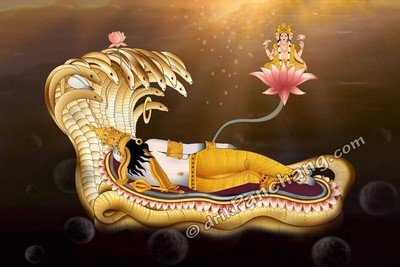













Devotees can decide the type of Ekadashi fasting during Sankalp according to their will power and physical strength. In religious texts four types of Ekadashi fasting has been mentioned.
1. Jalahar (जलाहर) i.e. Ekadashi fasting with only water. Most devotees observer this fasting during Nirjala Ekadashi. However devotees can observe it on all Ekadashi fasting.
2. Ksheerbhoji (क्षीरभोजी) i.e. Ekadashi fasting on Ksheer. Ksheer refers to milk and milky juice of plants. But in Ekadashi context it should be all products made of milk.
3. Phalahari (फलाहारी) i.e. Ekadashi fasting on fruits only. One should consume only high class of fruits like mango, grapes, banana, almond, and pistachios etc. and should not eat leafy vegetables.
4. Naktabhoji (नक्तभोजी) i.e. having single meal in a day just before sunset. Single meal should not have any variety of grains and cereals including beans, wheat, rice and pulses which are forbidden during Ekadashi fasting.
Staple diet for Naktabhoji during Ekadashi fasting includes Sabudana, Singhada (Water caltrop and also known as Chestnut), Shakarkandi, Potatoes and Groundnuts.
For many Kuttu Atta (BuckWheat Flour) and Samak (Millet Rice) is also staple diet during single Ekadashi meal. However validity of both items as Ekadashi food is debatable as those are considered semi-grains or pseudo grains. It is better to avoid these items during fasting.
Since years we get queries related to Ekadashi fasting across the globe. Although, for someone born in religious Hindu family, such queries might look basic but there are Lord Vishnu devotees who get confused with basic Ekadashi timings given on Drik Panchang to observe Ekadashi Vrat.
These are Tithi timings given in Panchang (just similar to weekdays Sunday, Monday, etc. which begins at midnight and ends at next midnight) and help to decide the correct date to observe Ekadashi fasting. As Ekadashi Tithi might begin at any time of the day and mostly split over two days, on the basis of these timings one day is preferred over the other to observe fasting. Once you have fasting date you don't need them and we list them just for information. These timings are not needed to observe fasting.
No. As we mentioned above Tithi begin time is not needed for Ekadashi fasting. Ekadashi fasting always begins with Sunrise and mostly ends after next day Sunrise. Ekadashi is usually 24 hours fasting observed form local Sunrise to next Sunrise.
Having said that, it is also important to mention that devotees skip dinner made of all sorts of grains on previous night to avoid any residual food/grain in stomach when they begin fasting with Sunrise. In other words some devotees begin Ekadashi fast with sunset on previous day as per their devotion to Lord Vishnu.
When we list two dates for Ekadashi, to keep it simple, you take the first date and observe the fast for single day. First date is preferred over the second date when you decide to keep the fast for single day only. It is quite normal to have single day fasting even it is listed for two consecutive dates. If one has stamina, one can keep the fast for two days.
You begin the fast with local Sunrise which continues to next Sunrise. However fast is not always broken with next Sunrise. To get the full credit of fasting, Ekadashi fast is broken at an appropriate time after next day Sunrise which might prolong the fasting up to afternoon and beyond. Hence one can notice that for few fasting Parana time (i.e. time to break the fast) on next day is during lunch time.
Hari Vasara time is prohibited to break Ekadashi fast. If one cannot continue fasting till noon or in case of urgency one can break the fast, after Hari Vasara ends. However more appropriate time is after few hours of Hari Vasara end time.
In Hindu religious texts, Ekadashi fast has been described as the most sacred and fruitful fast. The fast of Ekadashi is dedicated to Lord Vishnu. If for some reason the fast is broken, then one should seek forgiveness while worshiping Him. Atone for your mistake and resolve not to repeat that mistake in future. The following deeds can be done for atonement.
Following solutions can be taken if Ekadashi fast is broken -
मन्त्रहीनं क्रियाहीनं भक्तिहीनं जनार्दन।
यत्पूजितं मया देव परिपूर्ण तदस्तु मे॥
ॐ श्री विष्णवे नमः। क्षमा याचनाम् समर्पयामि॥
Mantrahinam Kriyahinam Bhaktihinam Janardana।
Yatpujitam Maya Deva Paripurna Tadastu Me॥
Om Shri Vishnave Namah| Kshama Yachanam Samarpayami॥
Fasting and worship etc. are completely a matter of reverence and devotion. Therefore, even if you commit any mistake during the fast due to ignorance, have full faith in your deity and apologize to him. There is no need to be afraid but do not behave arbitrarily during the fast under laziness and carelessness. Lord Shri Hari Vishnu is completely aware of the feelings of all living beings and provides results accordingly.
Notes: All timings are represented in 24+ hour notation in local time of Fairfield, United States with DST adjustment (if applicable).
Hours past midnight are higher than 24:00 and fall on next day. In Panchang day starts and ends with sunrise.
Padmini Ekadashi falls during leaped month. Leaped month is also known as Adhika Masa, Malmas and Puroshhottam Masa. Ekadashi which falls during Gaura Paksha of Adhika Masam is known as Padmini Ekadashi. Hence no Lunar month is fixed to observe Padmini Ekadashi fasting and it is decided based on leaped month. This Ekadashi is also known as Adhika Masa Ekadashi.
On this page we list Ekadashi date and Parana time as observed in ISKCON temples. The date and Parana time given on this page might be different from those which are based on rules given in Dharma Sindhu and Nirnaya Sindhu.
ISKCON Ekadashi rules are similar to Vaishnava Ekadashi rules. However, dates and Parana time are calculated based on Gaurabda Calendar rules mentioned in GCAL program mostly followed by all ISKCON temples.
Some of points which are important to note that, Maha Dwadashi fasting prevails over Ekadashi fasting. Whenever, Ekadashi and Maha Dwadashi fasting are consecutive, ISKCON temples, rather observe fasting on Ekadashi day observe it on Maha Dwadashi day. In other words Shuddha Ekadashi fasting is abandoned due to importance of fasting on Maha Dwadashi day.
There are total 8 Maha Dwadashi which are observed by ISKCON -
Rules to determine Parana timings are not exactly same as those given in Dharma Sindhu but they don't contradict each other. ISKCON calendar considers Hari Vasara while calculating Parana timings.
Parana means breaking the fast. Ekadashi Parana is done after sunrise on next day of Ekadashi fast. It is necessary to do Parana within Dwadashi Tithi unless Dwadashi is over before sunrise. Not doing Parana within Dwadashi is similar to an offence.
Parana should not be done during Hari Vasara. One should wait for Hari Vasara to get over before breaking the fast. Hari Vasara is first one fourth duration of Dwadashi Tithi. The most preferred time to break the fast is Pratahkal and Parana time for most ISKCON Ekadashi fasting happens to be Pratahkal.